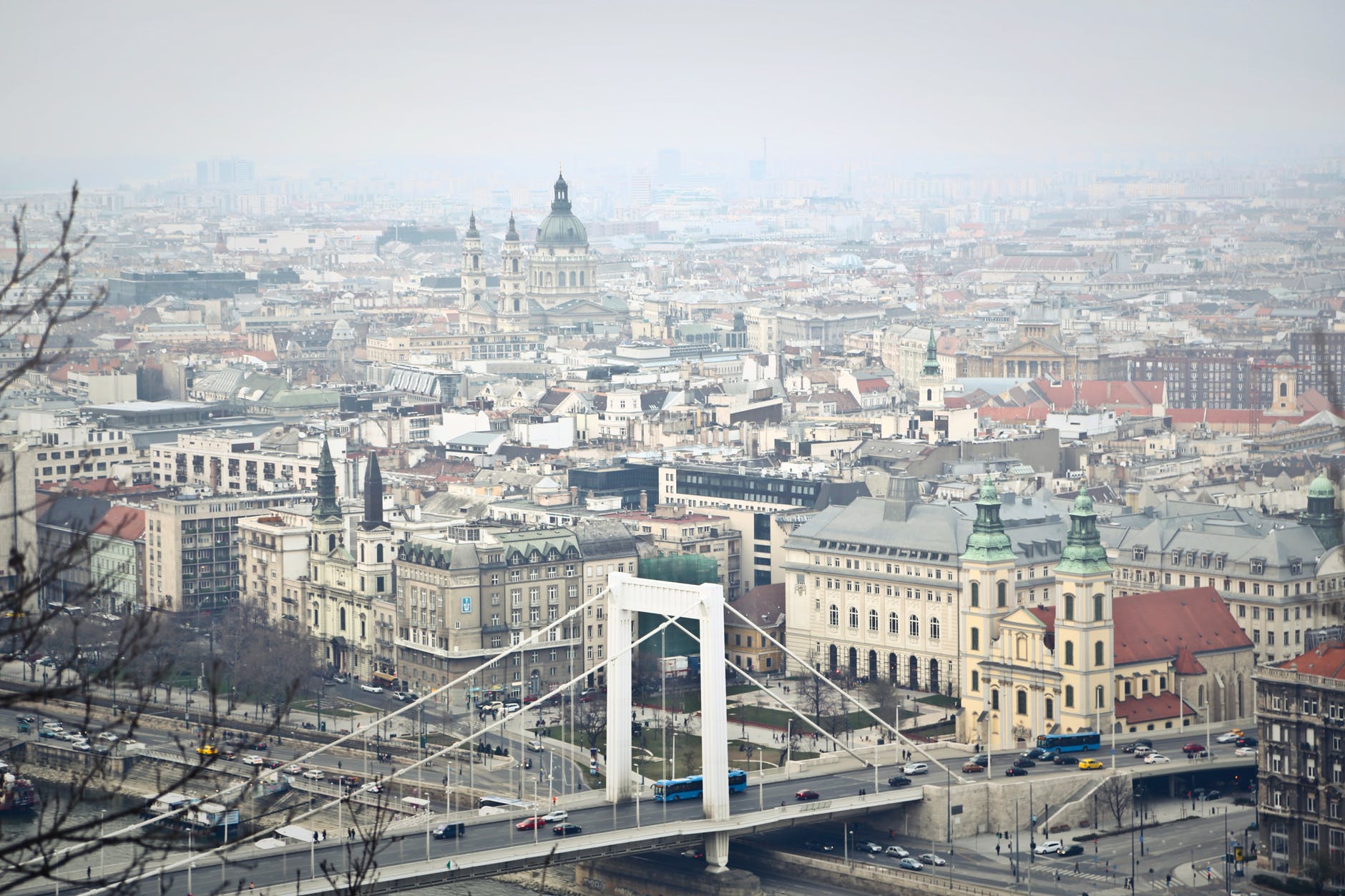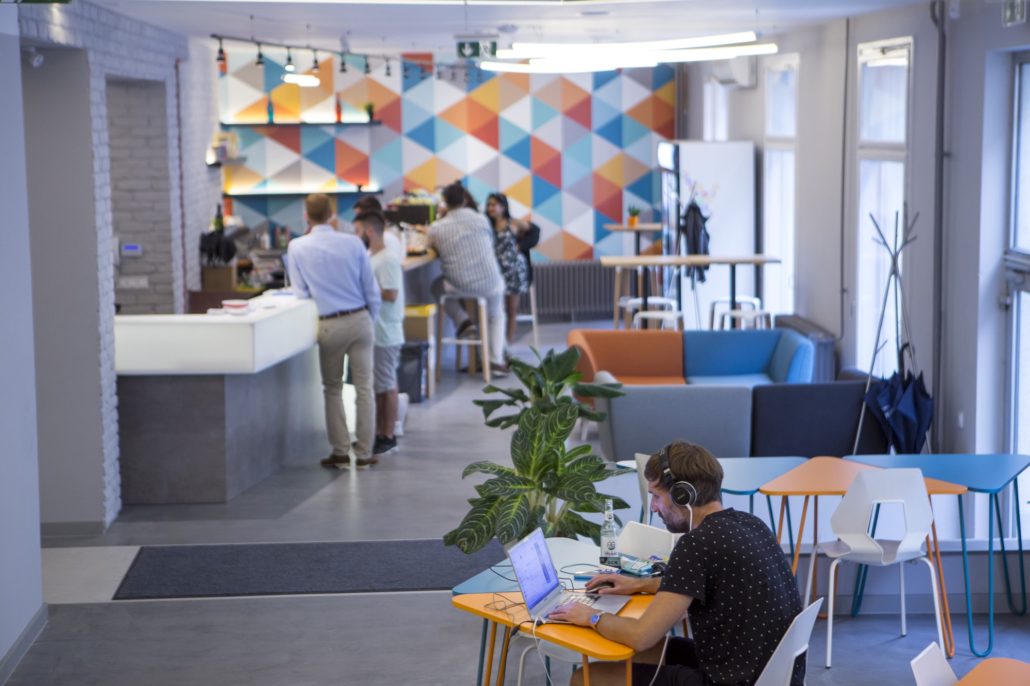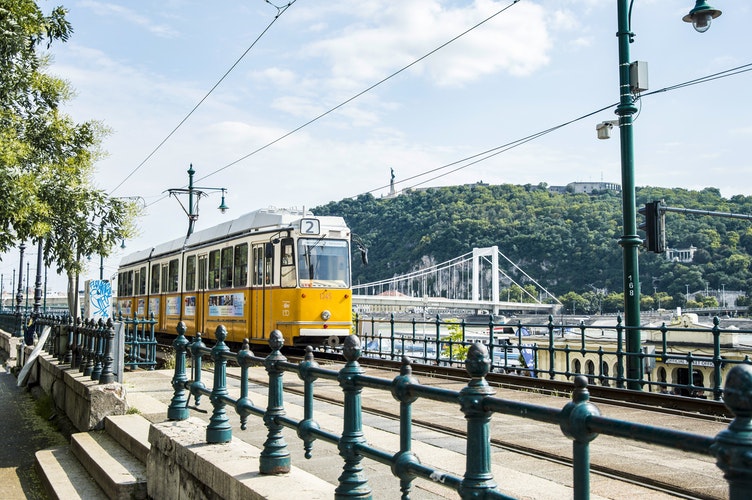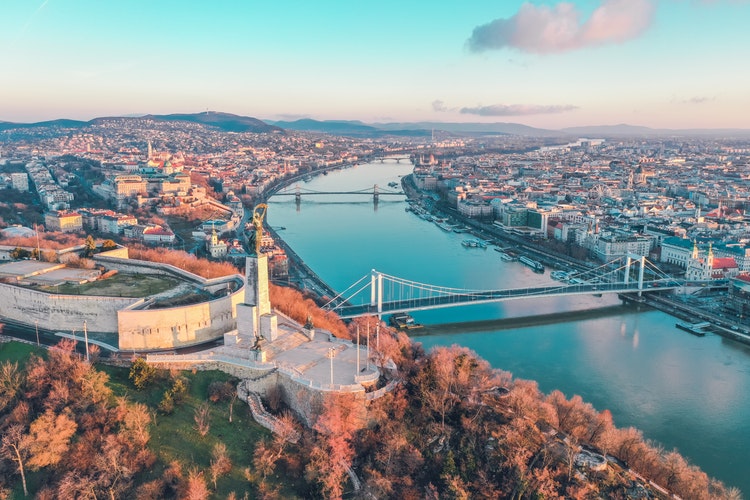The Digital Nomad scene in Budapest is promising with around 30 different types of coworking spaces, a slower, laid-back lifestyle and affordable prices. Nomads love the location of the city, built around a curve in the Danube River, with hilly Buda to the west, Obuda to the northwest and flat, commercial Pest across the river to the east. The Hungarian capital’s charm is in the cultural influences of its history with the Ottoman Turks, Austrian Habsburgs, and Soviet-led communist regimes. It has a treasure trove of baroque, neoclassical and art nouveau buildings and there is so much to do in this city whether hiking up to Buda Castle, having lunch at the Great Market Hall, admiring the Parliament Building or visiting Margaret Island.
QUICK SUMMARY
| Pros | Cons |
|
Offers incredible value for money Very safe city Fun activities to do all year round One of the cheaper nomad destinations Fantastic entrepreneur community Wonderful Digital Nomad community |
The Nomad Community is still developing Many tourists in the summer season |
| Similar destinations: Vienna, Prague | |
When to go?
The shoulder seasons in the spring and fall, April to May and September to October are the perfect time to be in Budapest. It’s still warm but there aren’t as many crowds and prices are cheaper.
Where to stay?
 Budapest is divided into 23 districts numbered clockwise in widening circles. The old city of Buda is perched on green, rolling hills and covers Districts I and II, Óbuda district III, and Pest Districts V to X. Every district has its own character and many neighborhoods have kept a fairly mixed residential makeup. You may want to start by looking for accommodation close to the city center, where there are many fellow nomads and co-working spaces, and where getting around is easy.
Budapest is divided into 23 districts numbered clockwise in widening circles. The old city of Buda is perched on green, rolling hills and covers Districts I and II, Óbuda district III, and Pest Districts V to X. Every district has its own character and many neighborhoods have kept a fairly mixed residential makeup. You may want to start by looking for accommodation close to the city center, where there are many fellow nomads and co-working spaces, and where getting around is easy.
Újlipót
The inner section of District 13 called Újlipótváros is a super cute, really chilled, quiet area north of the city center. Its’ rows of modernist houses, mainly Bauhaus style, are different to the rest of the city’s late-19th-century revival buildings. Many also offer views onto the Danube River with high price tags. This peaceful neighborhood is popular for young, upwardly-mobile Hungarian families, especially middle-class Jewish families with children. It has cafes, bookstores, florists, art galleries and design shops giving it a relaxed feeling. The center of activity is along Pozsonyi Road, especially the section from Jászai Mari Square to Szent István Park. Start at Láng-Téka Könyvesbolt, specializing in books by Jewish authors from around the world and stroll through Szent István Park with its beautiful flowers. The houses surrounding it are considered the crown jewels of modernist Hungarian architecture.
Belváros-Lipótváros
District V, also called Belváros-Lipótváros, runs along the Danube River in a long band from Margaret Bridge in the north to Liberty Bridge in the south. This beautiful, upmarket district is the true downtown of Budapest and is close to everything, but the party is still far away enough so that it’s not too noisy. It is home to many of Budapest’s main attractions including the Hungarian Parliament Building, Shoes on the Danube memorial, Chain Bridge and St. Stephen’s Basilica. The west side of Elizabeth Square is home to the Budapest Eye Ferris wheel and Liberty Square often hosts events and markets. Váci utca and Deák Ferenc ‘Fashion Street’ provide a shopping experience with high street brands. The district is walkable and well connected by public transit. The Danube-side promenade is perfect for enjoying the sunset. Belváros-Lipótváros is great if you want to stay in the city center and don’t mind paying a bit extra for it. But it is still possible to find affordable places too.
Erzsébetváros
If you are a “party animal”, District VII or Erzsébetváros, is your hood. It is situated in central Pest, an ultra convenient, fun and lively area to stay. The district is quite large and your best bet is to stay within the inner part as it becomes grungier the further you go from the center. This neighborhood is a hub for nightlife and the heart of hip and bohemian Budapest. It is an eclectic area with a rich Jewish history and a contemporary, edgy vibe. It was once part of the Jewish ghetto and is still home to kosher shops and the Moorish Grand Synagogue. The streets offer casual eateries, food vendors, quirky design shops and street art. This is where to come for hipster cafés, craft beer, ruin pubs, food trucks and speakeasies. Crumbling buildings stand next to freshly renovated architecture from every era. Despite the crowds and tourists, the district is safe. It is walkable and you have easy access to plenty of public transport options.
Várkerület
District I, also called the Castle District or Várkerület, is the historical part of Buda. This hilly area has a romantic feel and includes Castle Hill, as well as Tabán, Krisztinaváros and parts of Gellért Hill. The Castle District is the longest-established neighborhood in Budapest and is extremely accessible by foot and bicycle. The area was founded as a residence of nobles through centuries but eventually opened up to various people after WW2. Its unique history, together with its prime waterfront location, cultural festivals, and old-time charm makes the district stand out. It’s populated by some of the oldest residences in Budapest and is well known for attractions like the Buda Castle Royal Palace, the Fisherman’s Bastion and the Hospital in the Rock Museum.
It is a district that is touristy by day but quiet by night time. There are multiple bus lines and two tram lines that cross the district taking commuters to transportation hubs of the city. Castle Hill can be easily reached with bus number 16 from Deak Square, or taking the short but fun Funicular Railway (a 19th-century cable car) from the edge of the Chain Bridge on the Buda side. Considering that the 1st district is situated in a rather small area with emerging demand for residential properties, prices can be higher.
Accommodation in Budapest for Digital Nomads
Budapest has plenty of clean, well-equipped accommodation at affordable prices. When you arrive, you may want to stay in a hostel or rent a short-term flat while finding your new home. Suitable accommodation may range from around €900 to €1200 per month. If you are on a budget, older apartments for around €600 per month are available. Be prepared to sign a contract for at least six months, although many landlords prefer if you stay a year.
These handy links can help you find accommodation:
Short-term apartments
Roommates Budapest: for a room in a shared apartment
Hostels
Hostelworld: suitable couples, singles or backpackers.
Maverick Lodge Hostel: Suitable for couples or families.
Wombats City Hostel Budapest: Best for solo travelers and groups.
Vitae Hostel: Suitable for solo travelers and backpackers.
Long-term apartments
Expat.com Budapest
Join these Facebook Groups to find accommodation:
Coliving spaces
Loft Coliving / Hostel Budapest
Airbnb
Airbnb is a digital nomad favorite where you are usually able to find good monthly deals.
Coworking spaces and good places to work
If you prefer a proper office environment where you can work surrounded by fellow Nomads who you can bounce ideas off, Budapest has a number of creative co-working spaces. There are also many cafes with decent WiFi and delicious coffee.
Coworking spaces
 Kaptár: This busy, central office with plenty of natural light is a progressive, friendly community workspace. It is designed for those who want to be around inspiring people and want reliable, fast wifi in an excellent location.
Kaptár: This busy, central office with plenty of natural light is a progressive, friendly community workspace. It is designed for those who want to be around inspiring people and want reliable, fast wifi in an excellent location.
Impact Hub Budapest: This co-working space is a really quiet, innovative office with social innovators connecting to shape a better world. They provide inspiration and collaboration opportunities to grow the positive impact of your work.
Mosaik: This modern workspace mainly for tech digital nomads offers craft coffee, table tennis, a football table, and a relaxing courtyard to recharge between work.
Work-friendly cafes
Flow Speciality Coffee Bar and Bistro: Feel at home at this quality coffee shop with comfortable chairs, good music, wifi, and cheap vegan meals daily.
Madal Cafe: This relaxed, spiritual cafe with their latte art designs and zen motto of ‘Good coffee Good karma’ will ensure you have a pleasant workday.
Fabrik: This cute yet trendy cafe, with a free workshop room, is a great little spot offering a homely, multi-functional space to get work done.
Libraries where nomads can work
The National Library of Foreign Literature: Feel at home working among the collection of world, music and scientific literature.
BME OMIKK: Enjoy this quiet space to work in the heart of University Park with economic, natural sciences, fiction, and leisure literature.
Where to meet nomads?
With a thriving entrepreneurial culture, meeting nomads is easy in Budapest. You’re bound to bump into a few at the city’s coworking spaces or a networking event. Join these networking groups and upcoming events to meet fellow nomads in the city:
Facebook groups:
Events
- Budapest Digital Nomad Meetup – by Budapest Digital Nomads
- Digital Nomad Experiences and Beers – by Impact Hub Budapest
- Digital Nomad Konference by Digital Nomad Kit
Cost of living
Budapest is an affordable place to live the Nomad lifestyle. You may even consider it on the cheap side compared to other European cities since the currency remains the Forint. Of course, if you want to visit museums, concerts, on sightseeing tours, do some shopping, it becomes more expensive. To find more affordable prices, you need to get away from the city center. Grocery prices are similar to most European countries. However, if you try the local food markets, choose dorm rooms and public transportation, you should find the lifestyle quite cheap. Utilities may be around £200 per month including internet, electricity, and gas. Budapest is walkable but is large. Plan your days so you use public transport strategically. A monthly ticket valid for metro lines, trams and even some riverboats, is around €27. Avoid the official yellow taxis as they are very expensive. Rather choose Bolt.
Money (ATM info)
Visa and Mastercard are widely accepted and Amex cards are accepted by a few local banks too. ATMs are quite common, especially on the ring roads and large arteries. Check out your bank’s ATM locator for Budapest to lessen the hassle. It is advisable to find and use your own bank’s ATMs as you are charged extra for using an ATM not affiliated with your house bank. Nowadays there are also banks where this service is free. Download the AZIMO App to get money to your destination in 24 hours. Banks may charge to receive these payments. It works with the world’s leading banks and payment providers. Beat the rates with real-time currency alerts and transfer tracking. If you wish to open a local bank account, OTP Bank and K&H Bank offer a variety of choices.
Discount Card
The Budapest Card offers you unlimited public transport and discounts on many traveler services, as well as museums. Buy it at large metro station kiosks, tourist offices, and travel agencies for 6500/8000 FT.
WIFI speed info
Wifi speeds can be quite good depending on your provider and have actually become faster in the last year. (It only takes about 20 minutes to download a 5GB movie.) The cost of internet access is quite high with internet subscriptions among the most expensive in the EU relative to monthly income. Luckily most cafés have free wireless internet, but you can also get free internet in shopping centers. Big Internet Service Providers have hot spots around the city, but they charge for usage.
Getting Around
 How to get from the airport?
How to get from the airport?
Ferigehy International Airport is 24km from the city center. The cheapest way to get into the city from this airport is to catch bus 93 from Terminal 1 or bus 200 from Terminal 2 which lands up at Kispest metro station. From there, take the M3 metro line into the city. The total cost is between 540FT and 620 FT. Trains also link Terminal 1 with Nyugati station between 4am and 11pm. To get directly to where you stay, you can use the more expensive Airport Minibus (one way/return 2990/4990FT) or go with Zona Taxi which has fares from 5100FT to 5700FT for most central locations. Public Transport
Budapest has excellent public transport run by BKV and tickets are relatively cheap. Transport runs from 4:30am until 11:30pm. A weekly adult pass valid for all forms of transport costs around €16. You can buy tickets from vending machines at most stations or get personal service at Deák Ferenc Square central station. The three underground metro lines M1 yellow, M2 red and M3 blue meet at Deak ter in Pest. The city also has an extensive network of buses, trams, trolleybuses and efficient ferry systems.
Taxis
When it comes to taxis, overcharging is common. Never get into a taxi that doesn’t have a yellow licence plate, the logo of a taxi firm and a posted table of fares.
Rideshare
Ridesharing apps like BlaBlaCar allow you to share rides with locals to get around the city by pitching in for gas. Everyone is registered and verified so it’s quite safe. Request a seat, they approve you and off you go.
Bolt
Since there is no Uber, Bolt is the Uber of Budapest, providing easy and traceable rides. Bolt uses taxis instead of nondescript cars. The Bolt App will connect you with a reliable ride in minutes.
Bike rentals
Bikes are a popular way to get around the city. Rent them from MOL Bubi or Donkey Bike. MOL Bubi has green rental stations across the city. Register at one of the BKK customer service centres, buy a ticket and you’re ready to go. For Donkey Bike, get the app to rent a bike. Find your bike at the pick-up location and unlock it with the app. Return the rental bike to an available drop-off location, lock it and end your rental with the app.
E-scooters
Lime electric scooters are available along the Danube River. They are fun, safe and sustainable and a great way to make journeys in the city. No sitting in traffic or trying to find parking.
Cars and motorcycles
Most big car hire chains have branches at the airport. If you’re driving, make sure to buy an International Driving Permit. A standard daily rate is around €60 per day, excluding insurance, with unlimited kilometers. Petrol costs around 245FT per litre.
Mobile internet / SIM card use
You can use any European SIM card in Budapest as the connectivity borders have been abolished. Europeans should explore the pricing options of their original mobile carrier. If you wish to make phone call abroad or phone calls in Budapest you must expect quite high roaming fees if you are not using a European SIM card. The top three mobile phone carriers offering SIM Cards in Budapest are Telekom, Vodafone and Telenor. SIM Cards are only sold in Mobile phone shops. If you only need data, a SIM and 1GB data package costs HUF 1500 and is valid for 30 days while 3GB is HUF 3500. For Pocket WiFi, MyWebspot International Pocket WiFi Service provides unlimited high speed, secure internet with day passes. Each day in Budapest includes 1GB in high-speed 4G and reduced speed (at 512 KBPS above) until the next day. The day passes are activated automatically every day. This WiFi is shareable with up to 5 devices.
Travel Requirements
If you have a valid EU passport then you can enter and leave Budapest easily. If you are from outside the EU, simply apply for a tourist visa of 90 days. Remember your passport must be valid for at least three months beyond your stay.
TOP RESOURCES
- Best Things to do in Budapest by Lisa Lubin
- VIDEO GUIDE Budapest for digital nomads by Christoph Freelancer
- Best Vegan Places in Budapest by HappyCow
- Best Photography Spots in Budapest by Noel Morata
How to spend your free time in BUDAPEST

- Budapest is famous as the birthplace of puzzles such as the Rubik’s Cube. Visit the Budapest Pinball Museum. Pay the admission fee and play more than 130 pinball machines to your hearts delight.
- The Legendary Budapest Pool SPArty happens at the Scezhenyi Baths every Saturday during Spring, Summer and Fall. In the colder winter months, they move the party indoors to the Lukacs Baths. Buy tickets online in advance.
- Go hiking or take the chairlift up János Hill to the highest point in Budapest. Make your way to Zuglo by bus 291. Then either hike to the top from Normafa in about 30 minutes or take the chairlift from Zuglo in about 15 minutes. At the top, make your way to the Elizabeth Lookout Tower to see amazing city views.
- Visit the weekly Farmer’s Market on a Sunday morning from 9am to 2pm for an amazing brunch. Browse fresh and locally-grown produce, bread and pastries, cheese and meat products and sample famous Hungarian paprika and honey.
- Party the night away at the old ruin bars, old apartment houses that creative Hungarians have made into pubs.
- Explore Budapest caves with the Budapest Underground Caving Tour at Pal-volgyi Caves. Crawl and squeeze through tiny gaps, but also enjoy the big spaces too. Your guide will look after you on your adventure through the caves.
- The Spring Festival is a major cultural event with a series of opera, concert, ballet and theatrical performances in 40 different venues during late March.
- Visit the EatWith website and eat a home-cooked meal with locals. Locals post listings for dinner parties you can sign up for. There is a fee (everyone sets their own price), but it is a great way to make local friends.
- Sziget Music Festival is a week-long, international sound-fest in late July or early August over seven days on the Danubian Island in northern Budapest. The festival features major headline performances, art, dance, and local Hungarian bands.
- Go to the Hungarian Formula One Grand Prix at Mogyorod in mid-August.
- Enjoy the Budapest International Wine Festival in September tasting award-winning Hungarian wines at the Terraces of the Royal Palace in Buda.
- Have a meal at the Budapest Makery in the Jewish Quarter. At this do-it-yourself restaurant, you pick what you want from the menu, they bring you the ingredients and a tablet with instructions, and you make your own dinner. The food is delicious.
- Cycle the 200 kilometers of cycling paths around Budapest. Routes are easy to navigate, but if you prefer a guided tour there are plenty available.
